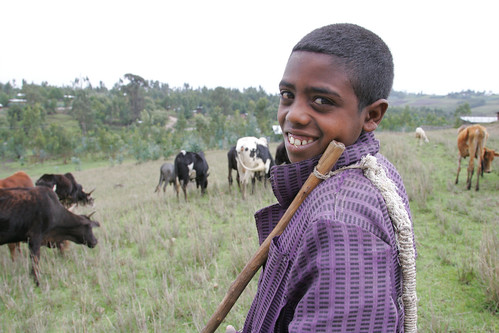Kemeria Hussien, a young woman at a milk market in Meisso District, West Hararghe Zone, Ethiopia, 2011 (photo credit: ILRI/Apollo Habtamu).
On 28 March 2013, a team from the project ‘Improving Productivity and Market Success of Ethiopian farmers (or IPMS project) gave a ‘livestock live talk’ seminar at the Addis Ababa, Ethiopia, campus of the International Livestock Research Institute (ILRI). This seminar, given for 70 people physically present and a few more connected virtually via WebEx, happened in the middle of the research planning workshop for a project that is a ‘sequel’ to IPMS, called ‘LIVES’: Livestock and Irrigated Value chains for Ethiopian Smallholders.
ILRI staff members Dirk Hoekstra, Berhanu Gebremedhin and Azage Tegegne have been managing IPMS, and learning from it, since its inception in 2004. The legacy as well as the learning from the IPMS project will be applied in the LIVES project, as well as other initiatives led by ILRI and other parties involved in IPMS.
What choices?
This project to ‘improve the productivity and market success of Ethiopian farmers’ was nothing if not ambitious, and, for a research organization, opted for some relatively daring choices:
- IPMS relied on developmental (uncontrolled) as well as experimental (controlled) research activities, which ranged along the spectrum of diagnostic, action-research and ‘impact research’ activities (so-called for the expected development impact they would have).
- Some activities were outsourced to development partners rather than undertaken by the research team.
- The project worked along entire value chains, from crop and livestock farmers and other food producers to rural and urban consumers, with the team restricting itself to introducing and facilitating the implementation of interventions validated by local stakeholders.
- Rather than focus on value chain interventions exclusively, the IPMS researchers investigated farming production systems as a whole and focused on the role of agricultural extension in the uptake of research results and their integration in interventions.
- The IPMS workers used ‘action learning’ methods, which appears to have enabled an on-going evolution in the development of their targeted value chains. This kind of learning approach also sped the adoption of new technologies and the implementation of interventions and encouraged the team to use failures as fuel to modify the project’s trajectory.
. . . Led to what insights?
Insights from the project team were at the core of this ‘live talk’, with the lessons IPMS learned simple and straightforward; some examples follow.
Technology generation by itself is not enough to achieve developmental outcomes and impacts – Several interventions in the value chain development approach need to be implemented together to achieve impact.
Research for development can be implemented well in a research environment, i.e., it is possible to combine rigorous research with development processes without sacrificing the quality of scientific research or the generation of robust evidence.
Knowledge management and capacity development—using, among other methods, innovative information and communication technologies and approaches such as farming radio programs, local information portals connected to local knowledge centres and e-extension—are key to development of responsive extension systems as well as women and men farmers working to transform subsistence agriculture into sustainable economic enterprises.
Gathering those lessons was itself far from straightforward. The IPMS team experienced difficulties in negotiating value chain developments and the specific interventions that were felt as necessary, and in making choices among all actors involved in the value chain (e.g., a failed experiment to market sunflowers) because of market failures and insufficient returns on investments. The team also realized that working in an adaptive manner across a broad value chain and extension framework implies letting go of control and of tight deadlines, but can improve relations among value chain actors and their joint interventions.
As ILRI’s new LIVES project is now in full swing, and as a new long-term ILRI strategy demands that ILRI take a more coherent approach to making development impacts, these insights from IPMS can help guide those undertaking new initiatives of ILRI and of its partners.
Watch and listen to this seminar here: https://www.ilri.org/livestream.
View the slide presentation here: Agriculture research for crop and livestock value chains development: the IPMS experience, presentation by Dirk Hoekstra, Berhanu Gebremedhin and Azage Tegegne on 28 Mar 2013.
You can contact the IPMS/LIVES team at lives-ethiopia [at] cgiar.org.
Note: ‘Livestock live talks’ is a seminar series at ILRI that aims to address livestock-related issues, mobilize external as well as in-house expertise and audiences and engage the livestock community around interdisciplinary conversations that ask hard questions and seek to refine current research concepts and practices.
All ILRI staff, partners and donors, and interested outsiders are invited. Those non-staff who would want to come, please contact Angeline Nekesa at a.nekesa[at]cgiar.org (or via ILRI switchboard 020 422 3000) to let her know. If you would like to give one of these seminars, or have someone you would like to recommend, please contact Silvia Silvestri at s.silvestri[at]cgiar.org (or via ILRI switchboard 020 422 3000).



